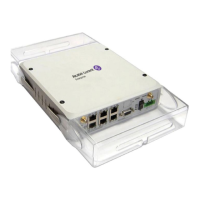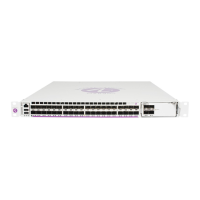Port Features
Page 36 7705 SAR OS Interface Configuration Guide
Inverse Multiplexing Over ATM (IMA)
IMA is a cell-based protocol where an ATM cell stream is inverse-multiplexed and
demultiplexed in a cyclical fashion among ATM-supporting channels to form a higher
bandwidth logical link. This logical link is called an IMA group. By grouping channels into
an IMA group, customers gain bandwidth management capability at in-between rates (for
example, between DS1 and DS3 or between E1 and E3) through the addition or removal of
channels to or from the IMA group.
The 7705 SAR supports the IMA protocol as specified by the Inverse Multiplexing for ATM
(IMA) Specification version 1.1.
In the ingress direction, traffic coming over multiple ATM channels configured as part of a
single IMA group is converted into a single ATM stream and passed for further processing
to the ATM layer, where service-related functions (for example, Layer 2 traffic management
or feeding into a pseudowire) are applied. In the egress direction, a single ATM stream (after
service functions are applied) is distributed over all paths that are part of an IMA group after
ATM layer processing takes place.
An IMA group interface compensates for differential delay and allows for only a minimal
cell delay variation. The maximum differential delay supported for IMA is 75 ms.
The interface deals with links that are added or deleted, or that fail. The higher layers see
only an IMA group and not individual links; therefore, service configuration and
management is done using IMA groups, and not individual links that are part of it.
The IMA protocol uses an IMA frame as the unit of control. An IMA frame consists of a
series of 128 consecutive cells. In addition to ATM cells received from the ATM layer, the
IMA frame contains IMA OAM cells. Two types of cells are defined: IMA Control Protocol
(ICP) cells and IMA filler cells. ICP cells carry information used by the IMA protocol at
both ends of an IMA group (for example, IMA frame sequence number, link stuff indication,
status and control indication, IMA ID, Tx and Rx test patterns, version of the IMA protocol).
A single ICP cell is inserted at the ICP cell offset position (the offset may be different on
each link of the group) of each frame. Filler cells are used by the transmitting side to fill up
each IMA frame in case there are not enough ATM stream cells from the ATM layer, so a
continuous stream of cells is presented to the physical layer. Those cells are then discarded
by the receiving end. IMA frames are transmitted simultaneously on all paths of an IMA
group, and when they are received out of sync at the other end of the IMA group link, the
receiver compensates for differential link delays among all paths.

